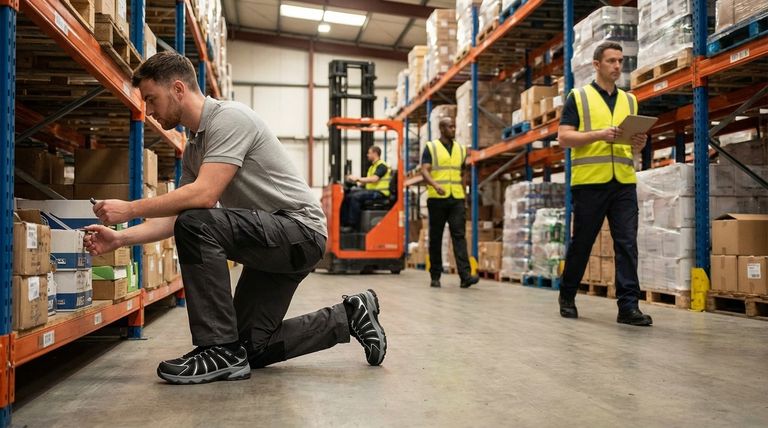Shoe fit is the definitive factor governing your physical endurance and long-term health during all-day wear. It is not merely a matter of comfort; proper fit determines your body's ability to maintain alignment, preventing a cascade of musculoskeletal issues from the feet up to the back. Without precise fit, even advanced cushioning technologies fail to protect against fatigue and injury.
The most expensive shoe will fail you if the fit is incorrect. Functional support—defined by torsional rigidity, accurate width, and heel stability—is the only reliable defense against chronic pain and joint strain during prolonged shifts.

The Physiology of All-Day Wear
The Kinetic Chain Reaction
Fit impacts far more than just your feet. Your feet act as the foundation for your entire skeletal structure. When a shoe fits poorly, it compromises weight distribution, leading to misalignment in the ankles, knees, hips, and lower back.
Prevention of Chronic Pathology
Correct footwear is a preventative medical tool. Proper support mitigates common workplace injuries such as plantar fasciitis and heel pain. By stabilizing the foot, you reduce the muscle fatigue that accumulates over 8-10 hour shifts.
Impact on Cognitive Focus
Physical discomfort is a significant distraction. When your body fights to maintain balance in ill-fitting shoes, energy is drained rapidly. A correct fit preserves your physical energy, allowing you to maintain higher focus and productivity levels throughout the day.
The Technical Pillars of Fit
Torsional Rigidity
For all-day wear, a shoe must resist twisting. If you can wring a shoe out like a wet towel, it lacks the structure necessary for long-term support. A shoe should score at least a 3 out of 5 in rigidity tests to effectively support the foot's arch and structure.
Platform Width and Stability
A wide midsole platform provides a stable base for the foot. This prevents rolling and reduces the muscular effort required to stay upright. Combined with a stiff heel counter, this structure locks the foot in place to prevent friction and instability.
Volume and Toe Accommodation
Length is only one dimension of fit; width and volume are equally critical. The upper material must accommodate the foot's natural shape, including deformities like bunions. Sufficient toe room allows for natural splay, which is essential for balance and circulation.
Environmental Management
Breathability is a functional requirement, not a luxury. Materials like mesh or full-grain leather allow heat to escape. This prevents the excessive sweating and friction that occur during long durations of movement, reducing the risk of blisters.
Understanding the Trade-offs
Softness vs. Support
There is a common misconception that "softer is better." While shock absorption (via EVA foam or gel) is necessary for walking on hard surfaces, excessive cushioning without structure can increase fatigue. Your muscles must work harder to stabilize a foot on a platform that is too squishy.
Durability vs. Weight
Lightweight designs reduce leg fatigue, but often at the cost of durability. High-quality materials that offer slip resistance and structural integrity naturally add weight. You must balance the need for a light shoe with the necessity of a durable outsole that protects against workplace hazards.
Making the Right Choice for Your Goal
To ensure you select footwear that supports your specific needs, consider your daily activity patterns:
- If your primary focus is stationary standing: Prioritize high torsional rigidity and a wide, flat platform to minimize muscle stabilization effort.
- If your primary focus is high-volume walking: Prioritize shock absorption and flexible upper materials to cushion impact and allow heat dissipation.
- If your primary focus is joint protection: Prioritize arch support and a firm heel counter to maintain vertical alignment and protect knees and hips.
Treat your footwear as a critical piece of equipment; proper fit is the foundation of your career longevity.
Summary Table:
| Technical Pillar | Key Feature | Benefit for All-Day Wear |
|---|---|---|
| Torsional Rigidity | Resists twisting | Supports foot arch, reduces fatigue |
| Platform Width | Wide, stable midsole | Prevents ankle rolling, improves balance |
| Volume & Toe Room | Accommodates natural foot shape | Enhances circulation, prevents blisters |
| Heel Counter | Firm heel structure | Locks foot in place, ensures stability |
Equip Your Workforce for the Long Haul
As a large-scale manufacturer, 3515 produces a comprehensive range of footwear designed for the demands of all-day wear. For distributors, brand owners, and bulk clients, we offer:
- Precision Engineering: Our shoes are built on the technical pillars of fit—torsional rigidity, stable platforms, and secure heel counters—to protect against fatigue and injury.
- Durability Meets Comfort: We balance lightweight materials with durable, slip-resistant outsoles to ensure long-lasting performance in any work environment.
- Scalable Solutions: From stationary standing to high-volume walking, we have the production capabilities to deliver the right fit and support for any workforce.
Invest in footwear that supports productivity and well-being. Let's discuss how our boots and shoes can become a critical part of your team's safety and success.
Contact 3515 today for a consultation
Visual Guide

Related Products
- Premium KPU Athletic Safety Shoes for Wholesale
- Custom Safety Shoe Manufacturer for Wholesale & OEM Brands
- Premium Lightweight Safety Shoes for Wholesale & Bulk Orders
- Wholesale Durable Breathable Safety Boots Custom OEM Manufacturer
- Durable Canvas Work Shoes with Rubber Lug Sole | Wholesale Manufacturer
People Also Ask
- What do the markings on ASTM-compliant safety shoes indicate? Decode the Safety Labels for Maximum Protection
- What are the conditions faced by employees in meatpacking and poultry slaughter plants? Navigating Pervasive Slip Hazards
- What are the EN ISO 20345 norms for safety shoes? A Guide to Choosing the Right Protection
- What materials are used in the construction of these boots? A Guide to Velour Leather, Textile & PU Soles
- Why is expert help recommended when selecting safety shoes? Ensure Perfect Fit & Hazard Protection



















